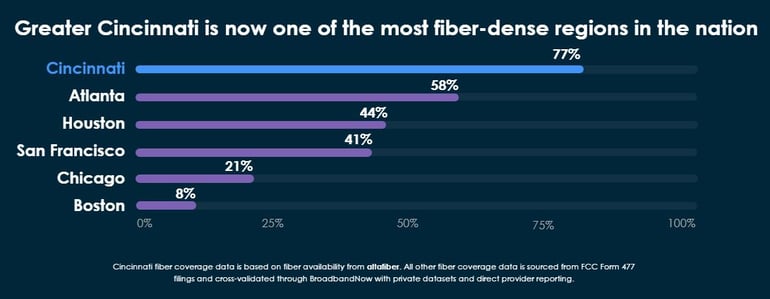Fiber brought to you by altafiber
Why fiber?
The demand for data and bandwidth continues to accelerate as people increasingly rely on their home’s internet connection for everything from communication to entertainment, remote work, online gaming, banking, shopping, and more. Traditional metallic cable networks – like copper and coaxial cable – have reached the limits of their capabilities causing many internet providers to begin upgrading their infrastructure with fiber to meet customer demand for faster speeds. Fortunately, altafiber has already invested over $1.5 Billion to build and expand our next-generation fiber network throughout Southwest Ohio, Northern Kentucky and Southeastern Indiana. This investment has made the Greater Cincinnati area one of the most fiber-dense regions in the nation, and we aren’t done yet. We are continuing to expand our fiber network to more cities and people.
Experience the fiber difference
There are many reasons to connect your home to altafiber's 100% fiber network.
More Bandwidth
Your internet speeds depend on how much data the network can transfer. A fiber-optic cable has approximately 10,000* times more bandwidth than a traditional metallic cable.
Faster Download Speeds
Download speed is the rate at which your connection can retrieve information from the internet. Download speeds are important for activities like streaming a movie in 4K, online gaming, and videoconferencing. altafiber currently offers download speeds up to 2 Gig.
Faster Upload Speeds
Upload speed is the rate at which your connection can send information to the internet. Upload speed is important for videoconferencing, posting videos, online gaming, and submitting large files for work or school. altafiber offers upload speeds up to 1 Gig. Non-fiber networks often top out at less than 50 Mbps upload speed.
99.99% Reliability
Fiber-optic cables transmit data via pulses of light along glass or plastic fibers. This method is more efficient over long distances and less susceptible to interference from electromagnetic signals than copper wiring.
Understanding more about Fiber network technology
Speeds over WiFi: Myths & FAQs
Upload and Download Speeds
What is Fiber Internet?
Blog: Why you need to start paying attention to your upload speed
Your Internet's upload speed determines how fast you can send content to the Internet. An increase in activities such as video conferencing, sending content, and live streaming have made upload speeds even more important.
Blog: Fiber is the future and the future is now
Communications networks across the country have been put to the test as tens of millions of people have transitioned to working and learning from home. Read about the advantages of having fiber Internet at work and home, and why the necessity for these higher speeds is here to stay.
Blog: altafiber is going green with our fiber investment
altafiber has committed to reducing our greenhouse gas and carbon emissions by 40% by 2030. Learn more about how our fiber investment is a major factor in achieving this goal.

